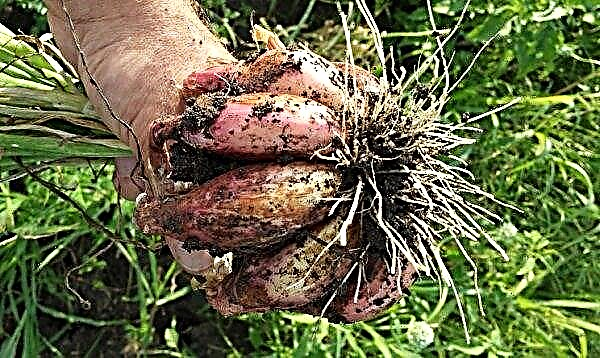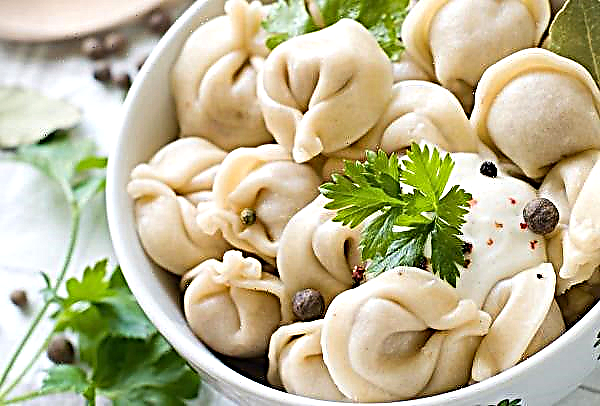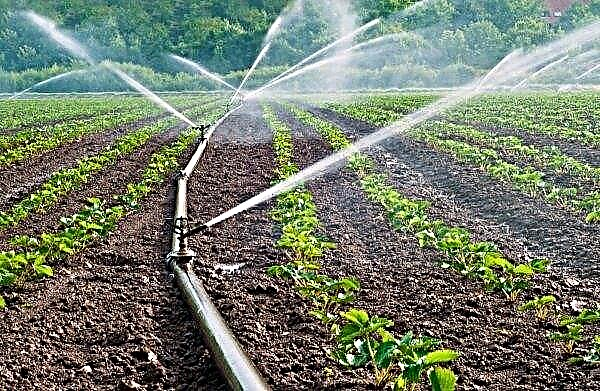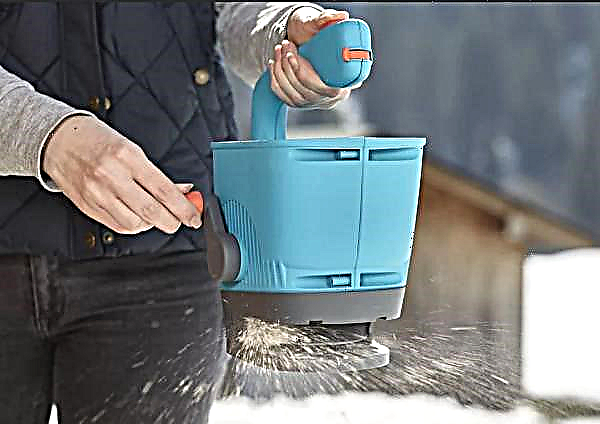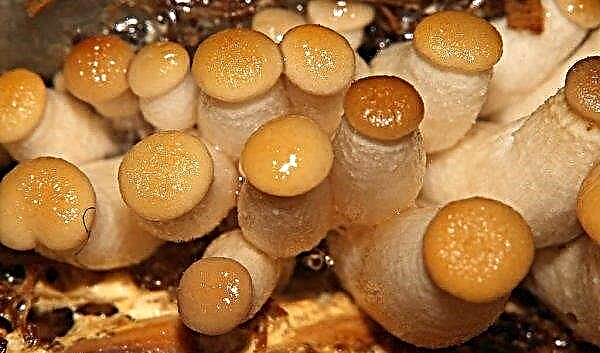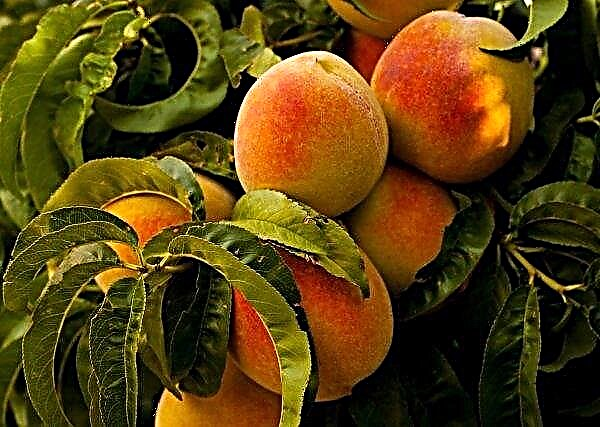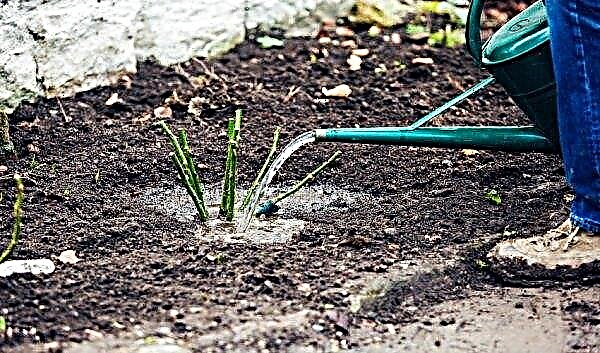Thanks to modern developments of breeders, it has become possible to grow tomatoes with previously known characteristics, resistant to diseases and changes in climatic conditions, fruitful. The hybrid of Berberan tomato F1 is presented in the article.
Grade description
Berberan Tomato F1 is a hybrid bred in the Netherlands by Enza Zaden breeders.
Did you know? Heat treatment of tomatoes not only does not impair the beneficial properties of the fruit, but rather improves them.
Variety characteristics:
- early ripening variety, fruits are ready for use after 100 days from the time of seed germination;
- the bush is tall, sprawling, reaches a height of 1.8 m;
- high productivity, up to 15 kg of fruit from 1 m²;
- the fruits are large, 200–250 g, often up to 500 g, rounded (slightly flattened), saturated red in ripening phase;
- the surface of the fetus is smooth, dense. The pulp is juicy;
- fruits are tied under adverse conditions, perfectly withstands high temperatures;
- the variety is distinguished by its extraordinary resistance to tomato diseases (fusarium, cladosporiosis, bronze mosaic, verticillium wilt);
- Tomatoes of the Berberan variety are distinguished by a long shelf life, they tolerate transportation well.

Advantages and disadvantages
- The undoubted advantages can be considered:
- productivity;
- disease resistance;
- insufficient lighting does not affect the formation of ovaries;
- resistance to temperature changes in the environment;
- long shelf life;
- transportability.
- Minuses:
- high cost of seed material;
- greenhouse crop, absolutely not suitable for cultivation in open field.
Self-growing seedlings
Growing healthy, strong seedlings means laying the foundation for a good crop. To do this, adhere to the recommendations of specialists.
Sowing dates
The seeds of the Berberan F1 hybrid are sown on seedlings in late March - early February.
Important! Use soil from the site where vegetables such as cabbage, onions, carrots were cultivated last season.
The soil
When choosing soil for seedlings, it is advisable to give preference to ready-made mixtures with a predominance of peat with a pH in the range from 5.5 to 7.
Options for the composition of soils compiled independently:
- 1st option: peat and sod land (2 parts of each component), sand (1 part);
- 2nd option: prepared soil for tomato seedlings (1 part), disinfected soil from the ridge (1 part).
Whatever soil is used when growing tomato seedlings, it must be decontaminated. The most effective and affordable way is the use of biological fungicides - Fitosporin, Gamair, Gliocladin. Also, as a prophylaxis of diseases and pests, the soil is calcined at high temperature (the probability of destruction of nutrients is high), it is frozen out (laborious), and steamed.
Capacity for growing
Berberan tomato seedlings do not tolerate the picking process, so the seeds are sown in separate vessels:
- pots for seedlings;
- peat pots;
- large disposable glasses with drainage holes.
Did you know? Yellow tomatoes are less nutritious than red tomatoes.
Seed preparation
Seeds intended for planting are soaked in brine (1 teaspoon of salt in a glass of water) for 10 minutes. Empty, inferior float to the surface of the liquid. They are not fit. The next stage is disinfection, since there is a high probability of finding pathogenic microorganisms on the surface of the seeds. To do this, place the seeds in a dark pink solution of potassium permanganate for about half an hour. To increase productivity, it is recommended to place the seeds for 24 hours in a solution of "Epina", potassium humate or sodium humate. From home remedies use aloe juice, potatoes. After this procedure, the seeds are not washed, but only dried. Germination and hardening of seeds is also used as a preplant planting.
To increase productivity, it is recommended to place the seeds for 24 hours in a solution of "Epina", potassium humate or sodium humate. From home remedies use aloe juice, potatoes. After this procedure, the seeds are not washed, but only dried. Germination and hardening of seeds is also used as a preplant planting.
Sowing seeds
In peat pots or plastic cups filled with nutritious soil, 2-3 tomato seeds are placed at a distance of about 1 cm from each other and sprinkled on top with a layer of about 10 mm. Vessels (for ease of movement) are placed on a pallet, covered with plastic wrap on top. Subsequently, the strongest sprout remains, less developed seedlings are removed.
Video: sowing tomato seeds
Seedling Care
First, the pallets are placed in a dimly lit place until the first shoots appear, after which the film is removed, and the seedlings are placed on a windowsill or other place with good lighting. Watering plants is carried out with water at room temperature and only when the soil dries (approximately once every five days). An excess of moisture leads to thinning, and in extreme cases, rotting of the stem, the seedlings' resistance to low temperatures decreases.
In addition to natural light, it is necessary to take care of additional sources of illumination, since a tomato is a light-loving plant, and for the full development of seedlings, the so-called additional illumination is required. For this, fluorescent lamps, phytolamps (diode lamps) are used. Until the plants have grown stronger, it is necessary to avoid drafts and a sharp change in temperature in the room with seedlings.
Later, when the seedlings get stronger, you can begin hardening by placing pallets with seedlings for a while on the balcony (porch), where the temperature is much lower than in the room. Tomato seedlings (from planting seeds to moving seedlings in the open ground) are fed 3 times - one feeding in two weeks.
Nutrient mixtures should be alternated:
- urea (0.5 g) + potassium salt (1.5 g) + superphosphate (4 g) is dissolved in one liter of water;
- in two liters of hot water stir wood ash (1 tbsp. l). The solution is kept for a day, then filtered;
- humate top dressing (use should be according to the annotation on the label).

Seedling hardening
In order to obtain viable tomato plants that can easily undergo a sharp change in temperament, lighting, humidity during transplantation, it is necessary to harden. About half a month before planting in the tank, containers with seedlings are taken out into the fresh air for half an hour, increasing the time of stay every day.
Important! The material for tying plants can serve as a soft cotton natural fabric, cut into long strips that will not injure the plants during its growth.
It is necessary to ensure that plants do not receive a sunburn, avoid excessive moisture. A week before the alleged transplant, watering is generally stopped. It will not bring harm to plants, but cold resistance will increase.
Planting seedlings in a permanent place
Transplanting seedlings of tomatoes of the Berberan variety into the greenhouse is carried out in mid-May. Since this variety is characterized by spreading stems, it is necessary to maintain a distance between the planting pits of at least 40-50 cm. It must be taken into account that the plants will have to be tied up during the growth process, so you should take care of the supporting structures in advance.
Care Tips
Consider information about caring for tomato plants in a greenhouse.
Watering
The main feature of tomato irrigation is dosage and frequency. This vegetable crop does not need frequent and plentiful watering, once every five days it is enough to pour 5 liters of water under each plant (temperature - not lower than + 20 ° C), and during the period of active flowering - up to 10 liters. Avoid getting water on the leaves of plants to avoid rot and burns.
Top dressing
Feed the plants with a mixture of rotted manure and nitrophoska (1 teaspoon per 10 liters of water) should be 14 days after planting in the greenhouse. Under one plant make a liter of such fertilizer. The next time the fertilizer is produced 10 days after the first. A mixture is prepared: potassium sulfate (1 tsp) and Fertility (1 tbsp.) Are dissolved in 10 liters of water. The amount of nutrient mixture per bush is 1 liter. During the entire growing season, it is desirable to fertilize plants 3 times with such a composition.
Stepson
A bush of tomatoes of Berberan is formed by one (two) stems. In addition to pinching the side shoots, the top of the bush is also recommended to pinch. These manipulations will allow the formation of powerful fruit brushes without excessive growth of green mass.
Soil care
The condition of the soil in the greenhouse should be monitored with particular care, since an enclosed space with a moist microclimate contributes to the development of fungal and mold lesions of the soil layer. To avoid unpleasant moments, you should constantly loosen the soil for air exchange, while adding soil around the stalks of tomatoes (hilling). This will give resistance to the plant, which is especially important during the period of active fruiting. To reduce the growth of weeds, which are potential carriers of pathogenic microorganisms and pests, it is recommended to mulch the soil under the bushes with rotted straw or wood chips.
This will give resistance to the plant, which is especially important during the period of active fruiting. To reduce the growth of weeds, which are potential carriers of pathogenic microorganisms and pests, it is recommended to mulch the soil under the bushes with rotted straw or wood chips.
Bush tying
Variants and methods of garter of tomatoes in greenhouses depend on the variety and characteristics of the plants grown (low, tall, compact, sprawling, etc.). This can be trellis, individual support, plastic clips, on coarse mesh, etc.
Since Berberan tomato plants are powerful and tall, the garter needs to be carried out not only on the stem shoot, but also on the side shoots, since the fruits are large, gathered in the brush, so a vertical trellis with a vertical rope - wide, strong, is suitable for this variety.
Preventative treatment
The Berberan F1 hybrid is very resistant to diseases that are associated with solanaceous, but nevertheless it is worthwhile for preventive purposes to treat the bushes with the prepared Barrier, Barrier means 7 days after placing the seedlings in greenhouse soil and repeat again 20 days later. Prevention from harmful insects is carried out using insecticides.
Harvesting
Berberan tomatoes ripen to technical ripeness approximately three months after seed germination. If the plant is formed correctly, the fruits are heavy, bright red, glossy. The crop is plentiful, as the clusters consist of a considerable number of fruits. Perfectly tolerate transportation, have a long shelf life. From a culinary point of view, the fruits of the hybrid are universal. They are delicious fresh, salads, soups. They are fermented, salted, pickled. Dried and dried.
Summing up, it is worth noting that with consistent observance of simple techniques of agricultural technology, even a novice gardener can get a plentiful harvest of tomatoes of the Berberan F1 variety, since the hybrid is undemanding in care, and the fruits, if stored properly, will delight for many months.

